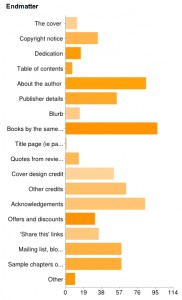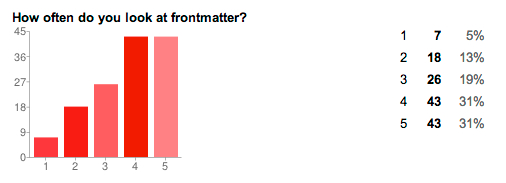Amazon has changed the way that it pays authors for books that readers borrow via Kindle Unlimited from a per book payment to a per page read payment. This has, obviously, caused uproar, which I’ve mostly ignored because I still loathe Amazon, am no longer self-publishing (though still writing), and don’t have a snail in the race.
However, people’s differing interpretations of what a per-page model will reward have been quite interesting, in that they’ve shown up one of publishing’s biggest blind spots: Quality.
Hugh Howey says that the new system will reward good books:
In fact, I think most people analyzing KU and the length of works to offer are getting it wrong. KU does not reward longer works: It rewards good works. It rewards gripping works.
In fact, KU will not reward good books, but books which are “finishable”, and some of those finishable books may be gripping, but being gripping is not a prerequisite for finishability.
Finishability is a concept that Michael Bhaskar, Chris McCrudden and I came up with during a Twitter conversation a while back. It means exactly what it sounds like it means: That quality of a book that keeps you reading, sometimes despite your better instincts.
Some books are delightfully finishable. You just sail through them like a skiff on friendly waves, barely aware of the act of reading. Nick Harkaway’s Angelmaker or Tigerman, for example. You feel almost bereft when you finish them.
Some books are finishable with a little effort: Harry Potter 4, which really needed to be half the length and put me off the rest of the series.
Some books you finish because although they are terribly written, they are still somehow compelling. Flood by Richard Doyle is one of the most appallingly written books I’ve ever read, but it’s a firm favourite of mine. There’s no craft there at all, no skill or finesse, yet the book is a page turner, and it’s a fun read because of the plot.
Some books you need to be bloody minded to finish. They’re awful. Really terribly awful. No craft, no plot, no joy at all, but you keep going because goddammit you are going to finish it because your paid good money for it. Harry Turtledove’s Supervolcano: Eruption is the perfect example. Only stubbornness kept me going through this turgid heap of shit.
Then there are the unfinishable books, the ones that life’s just too short for. The Casual Vacancy, for example. A book where I could not have cared less about the characters, and where I rapidly realised that I was resenting the time it was stealing from me.
So a finishable book is not necessarily a good book. There’s no linear relationship between quality and finishability. A shitty book can be very finishable. And some books are finishable not because of any inherent qualities at all, but because they have become a cultural touchstone which peer pressure demands that you finish. Whatever all the reverse-snobbery types say, 50 Shades is a truly shitty set of books, and their massive popularity has little to do with quality and much more to do with people not wanting to be the only one who hasn’t read them.
Which brings me to another point: Rarely does finishability have anything to do with popularity. Only for aberrations like 50 Shades does popularity force finishability, and it’s important to recognise that 50 Shades is an aberration, in every possible way. It is not how publishing usually works, so it teaches us nothing other than that aberrations happen.
So what actually is finishability? I’m going to borrow a concept from David Allen’s Getting Things Done, a book that many see as a productivity, bible although personally I didn’t manage to finish it. Allen talks about ‘open loops’, which he defines as:
anything pulling at your attention that doesn’t belong where it is, the way it is.
So open loops are things like tasks that you know you need to do but haven’t written down or done yet. Open loops lodge in the mind like a pip between teeth. They irritate. They draw your attention. They demand to be resolved. They cause procrastination.
GTD deals with this by getting you to write everything down so that your open loops are saved somewhere and you can put them out of your mind and focus on what you’re supposed to be doing. And it works. It’s why I keep comprehensive lists, and it’s also why tools like Omnifocus, for me, become the place where my To Do items go to die. If I write it down, I might discover that it’s not worth doing.
How does this relate to finishability? A finishable book is one that sets up open loops which your mind demands that you close. These might be big, meaty questions: Does she survive? Do they get it together? Who is the mysterious stranger? Does the island get blown up at the end? Sometimes they might be subtler: How does this peculiar relationship play out? Is this person really who they appear to be? How reliable is our narrator?
You can’t put the book down because you need to have your questions answered, and as soon as possible please. You need to know what happens. You have. To. Know. You cannot go through life not knowing.
This is why books that end without answering the key questions that they’ve set up are so fundamentally irritating. You are robbed of the opportunity to close that damn loop, get rid of that mental pip that lodged in your brain. And worse, you know that you’ll never be given the answers (unless they come in a sequel).
An authors ability to set up compelling questions in the reader’s mind has no relationship to how good they are as a writer. People love Dan Brown not because of the grace of his prose, but because he knows how to pace the opening and closing of loops. You have a constant flow: Each new open loop provides a reason to keep reading, each closing loop gives you a jolt of satisfaction at a “task” completed.
Amazon’s new pay-per-page regime will not reward long or short books, or good books, or well written books. It will reward finishable books, and particularly easily finishable book.
The thing that worries me is that not every book that is worth finishing is easy to finish.
{ Comments on this entry are closed }








